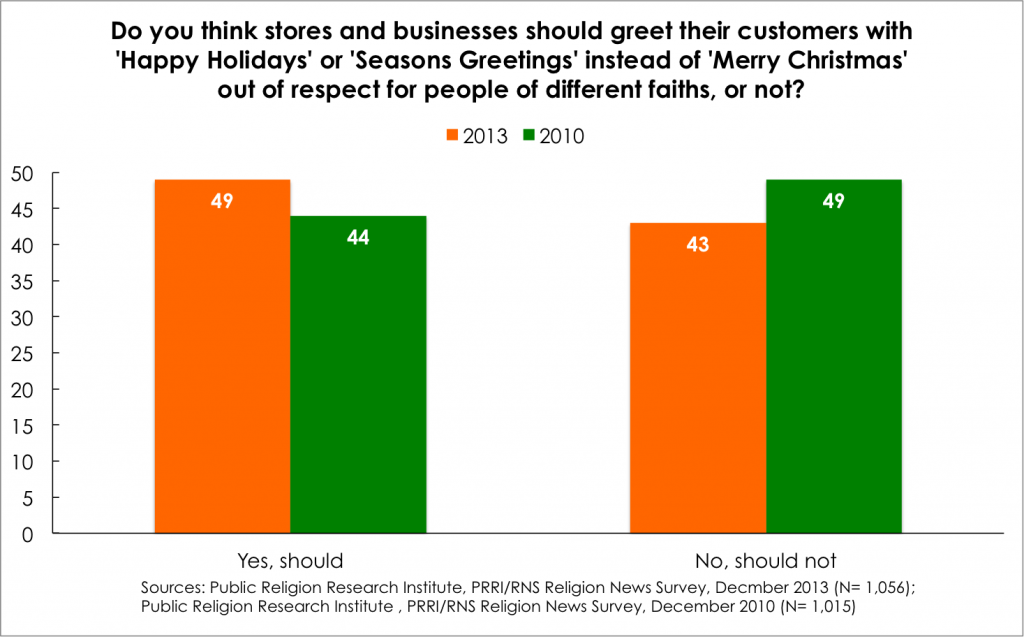Americans Shift Preference for “Happy Holidays” over “Merry Christmas”
I. The Battle Lines in the “War on Christmas”: Religious, Political, and Generational
Nearly half (49%) of Americans agree stores and businesses should greet their customers with “happy holidays” or “season’s greetings” instead of “merry Christmas” out of respect for people of different faiths. However, a substantial minority (43%) disagree. Support for saying “happy holidays” or “season’s greetings” is up slightly since December 2010, when 44% preferred that businesses use less religious greetings.
White evangelical Protestants are significantly more likely than other religious groups to say stores should use “merry Christmas” instead of “happy holidays,” with 62% saying they prefer that businesses use the explicitly religious greeting. White mainline Protestants and Catholics are more divided. Among white mainline Protestants, 46% say they prefer businesses to use “merry Christmas” but 43% disagree. Half (50%) of Catholics say they prefer stores use “happy holidays”, but a substantial minority (44%) disagree. Majorities of minority Protestants (55%) and the religiously unaffiliated (58%) say stores should use “happy holidays” rather than the more religious greeting.
The political divisions are stark. Roughly 6-in-10 (61%) Republicans favor using “merry Christmas” over “happy holidays,” while nearly as many (58%) Democrats say the opposite.
There is also a wide gulf of opinion between the youngest and oldest Americans. Nearly two-thirds (66%) of young adults (ages 18-29) support stores and businesses using a non-religious greeting, a view shared by fewer than 4-in-10 (39%) of America’s seniors (ages 65 and older).
II. Christmas: A religious holiday for most, but not all, Americans
In December, 84% of Americans report that they celebrate Christmas and no other holidays; 6% celebrate Christmas along with some other holiday such as Hanukkah, Kwanzaa, or winter solstice; 6% celebrate some other holiday but not Christmas; and 5% say they do not celebrate any holidays in December.
Among Americans celebrating Christmas this year, most will celebrate it as a strongly religious (42%) or somewhat religious (31%) holiday. But more than one-quarter (26%) of Americans celebrating Christmas this year will do so largely as a non-religious holiday.
There are strong religious differences in how Americans celebrate Christmas. Among those who say they will celebrate Christmas, white evangelical Protestants (71%) are more likely than minority Protestants (54%), Catholics (49%), white mainline Protestants (38%) or the religiously unaffiliated (6%) to report that they celebrate Christmas as a strongly religious holiday.
Seniors are nearly twice as likely as young adults to say they will be celebrating Christmas as a strongly religious holiday (51% vs. 26%).
Overall, Americans are as likely to say they currently celebrate Christmas as a religious holiday as they did as a child. Similar numbers of Americans say they grew up celebrating Christmas as a strongly religious (39%), somewhat religious (31%), or not too religious holiday (26%).
The most popular activity among those celebrating Christmas is watching Christmas movies such as “It’s a Wonderful Life,” or “A Christmas Story.” Nearly 8-in-10 (79%) report that their family watches Christmas movies during the holiday. Nearly 6-in-10 (59%) say they will attend religious services on Christmas Eve or Christmas Day. Fewer of those celebrating Christmas will read the Christmas story from the Bible (36%), or read the story, “Twas the Night before Christmas” (36%).
Among those celebrating Christmas, white evangelical Protestants (68%) and minority Protestants (57%) are much more likely than white mainline Protestants (27%) or Catholics (28%) to report reading the Christmas story from the Bible.
Nearly half (49%) of Americans say they believe the story of Christmas – that is, the virgin birth, the angelic proclamation to the shepherds, the star of Bethlehem, and the wise men from the East – is historically accurate. By contrast, four-in-ten (40%) say it is a theological story to affirm faith in Jesus Christ. Roughly 1-in-10 (11%) Americans say they are not sure.1
A majority of every major religious group affirms the story of Christmas to be historically accurate, although there are notable differences in intensity. Eight-in-ten (80%) white evangelical Protestants agree that the Christmas story is historically accurate, as do 6-in-10 (62%) minority Protestants, a majority (56%) of white mainline Protestants and a slim majority of Catholics (51%). Nearly 7-in-10 (68%) religiously unaffiliated Americans disagree, saying it is a theological story designed to affirm faith in Jesus Christ.
Young adults (42%) are less likely to believe the story of Christmas is historically accurate than seniors (50%) or those ages 50 to 64 (56%).
Belief in the historical accuracy of the Christmas story in the Bible has dropped 18 percentage points during the last decade. In 2004, two-thirds (67%) of Americans said that the story of Christmas was historically accurate, compared to only 24% who said it was a theological story.1
III. Giving Gifts and Giving Back: Christmas and Holiday Spending & Charity
Americans who celebrate Christmas are personally planning to spend an average of $914 this Christmas and holiday season, although there are significant differences in spending levels across income and age groups.
Overall, about 1-in-10 (12%) Americans report that they will spend less than $100 on holiday gifts this year. Nearly half the country will limit their spending to between $100 and $499 (29%) or between $500 and $999 (20%). One-quarter of the public report that they will spend at least $1,000 including 15% who anticipate spending between $1,000 and $1,999 and 10% who are planning on spending more than $2,000.
Most Americans (66%) report that they are planning on paying off their Christmas and holiday bills in about a month. Twelve percent say they will take one or two months to pay off their bills, while nearly 1-in-10 (9%) say they will take at least three months to pay off their holiday debts. About 1-in-10 (12%) refuse to answer this question or say they do not know how long it will take to pay off their holiday bills.
Although the Christmas season is known to be stressful time of year, most Americans report they do not feel stressed about holiday spending. Six-in-ten (60%) Americans say they do not feel stressed about their spending, while 29% report feeling a little stress, and only 10% report feeling a lot of stress.
Levels of stress vary considerably by income level and spending amount. Nearly half (49%) of those with annual incomes under $30,000 a year report feeling at least a little stress, compared to 23% of those with annual incomes in excess of $100,000.
More than one-third (34%) of Americans celebrating Christmas report that they shopped for gifts at retail stores on Black Friday. Americans most likely to shop on Black Friday include those making between $30,000 and $50,000 a year (47%), young adults (50%), and black Americans (53%).
Nearly 8-in-10 (77%) Americans celebrating Christmas report that they give to charity or volunteer to help those less fortunate as part of their holiday celebration, including 85% of white evangelical Protestants, 84% of white mainline Protestants, 77% of minority Protestants, 77% of Catholics, and 64% of the religiously unaffiliated.
IV. The Distinct Profile of Evangelicals at Christmas
White evangelical Protestants have a distinct profile in their approach to the Christmas holiday. White evangelical Protestants (71%) are more likely than other Americans celebrating the holiday (42%) to say that they celebrate Christmas as strongly religious holiday.
They are also more likely to attend religious services on Christmas Eve or Christmas Day than other Americans who celebrate the holiday (77% vs. 59%). Similarly, compared to other Americans celebrating the holiday, they are much more likely to read the Christmas story from the Bible (68% vs. 36%).
Eight-in-ten (80%) white evangelical Protestants believe that the Christmas story is historically accurate, a view held by less than half (49%) of the general public. The average white evangelical Protestant spends considerably more on Christmas and holiday gifts than the average American ($1,153 vs. $914). White evangelical Protestants are more likely than Americans overall (62%) vs. 43%) to prefer that stores greet customers with “merry Christmas” as opposed to “happy holidays,” or “season’s greetings.”
Endnotes
1 Princeton Survey Research Associates/Newsweek Poll, December 2004.
Recommended citation:
Jones, Robert P., Daniel Cox, and Juhem Navarro-Rivera. “Americans Shift Preference for ‘Happy Holidays’ over ‘Merry Christmas.’” PRRI. 2013. http://www.prri.org/research/prri-rns-dec-2013-survey/.





